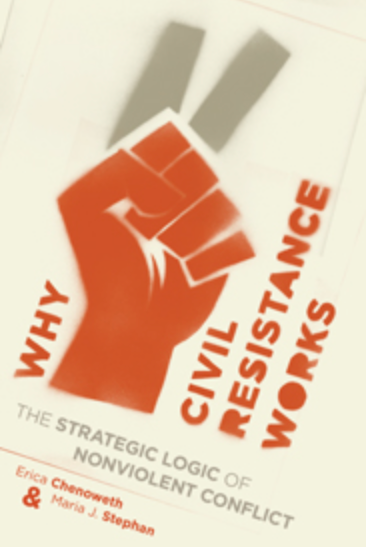How civil resistance works, maybe

Another book finished, an infinity more to read.
As promised, I have now finished, annotated, summarized, and mulled over a book I’ve been meaning to read for quite some time: Why Civil Resistance Works, by Harvard Kennedy School professor Erica Chenoweth and Maria J. Stephan, previously of the US Institute of Peace and currently of the Horizons Project. To my embarrassment, this is not the book in which Chenoweth comes up with her currently circulating 3.5% statistic (i.e. a movement for regime change is likely to succeed when 3.5% of a country’s citizens get involved), but it was worthwhile nonetheless — which is not to say that I entirely agreed with it. But we’ll get into that.
TL:DR;
The one-sentence version of the book is, nonviolence works, violence doesn’t, according to an analysis of 300 historical instances in which movements called for things like regime change, an end to occupation, and secession — mostly because it’s easier to recruit people to a nonviolent movement, and numbers matter most. The end.
Or at least – that's the theory.
Why this was a surprise
Given the book's description of previous research on this subject, it's very clear why this work has gotten so much attention. It is a fundamentally data-driven approach to a subject that appears, previously, simply not to have been. And I think this alone is worth a short aside. As insightful as it can be – I'm a big fan of C. Wright Mills' The Power Elite, for example – it continues to shock me how much historical and even contemporary "scholarship" on large patterns in human behavior appears to be just fuckin' sayin' stuff.
While I have never done a systematic review, there is a story I have heard many times in my extended hike through the many rooms of academia. Over the last century, field after field has been forced to reckon with humanity's increasing ability to handle empirical evidence in large volumes – and the fact that this evidence often definitively overrules what was once considered scripture. In psychology, in political science, economics, sociology, organizational behavior, this has happened again and again and again – but even fields like biology have also been fundamentally shaken by how much more you can learn by simply measuring the things you care about.
In 2011 – quite a bit later to the party than most, but a welcome addition nonetheless – the field of nonviolence studies appears to have undergone this same realization. Does nonviolence – work? Let's literally, finally, just actually measure it. This book is the product of that measurement.
One reason of course this story is so close to my heart is that it is my own fervent hope that I will be able to induce an even more seismic shift by bringing another field into the modern age. The study of life satisfaction as the first domino, yes – but eventually, our approach to the most fundamental principles of policy and governance. Stop guessing. Measure what matters. Act accordingly. But enough about that for now.
A more detailed summary
There is no resistance without supporters
In case the single sentence I gave you didn't quite do it, here are a few more. WCRW has a basic theory. The basic theory is, success in a movement is fundamentally a function of support. The more people you have, the harder you are to suppress, the more flexible you can be when you are suppressed, the wider the variety of ideas, contacts, and tactics you have access to, and of course the greater the amount of pressure you're able to exert. Lots of specific reasons are given but really, More People is Better is pretty self-explanatory.
From there, the effectiveness of nonviolence is introduced as practically just a corollary. A violent resister needs more training, more commitment, more equipment, more physical fitness, more secrecy, more security, etc. etc. Therefore, it will be harder to recruit them. Ergo, nonviolence is better.
I can't remember (or, they didn't say) if this particular hypothesized chain of events is tested statistically – meaning, if the influence of nonviolence directly causes success, or if it only influences numbers, and then numbers alone cause success – but the top line is that in their data, "nonviolent" coded movements come out as dramatically more successful, and more often, than "violent" movements.
Violence has clear drawbacks
If you see this distinction clearly, the immediate question is of course, what is the relative impact of one violent person compared to one nonviolent person? Or in other words, if you could get an equal number of people prepared for violence, would they be more effective overall? And I don't remember the book giving a clear answer.
However, the authors do make the convincing point that nonviolence has other positive effects – namely, that nonviolent movements are dramatically more like to result in democratic regimes once they succeed, at a rate of around 50% vs 6% for violent movements. Meaning there could be serious repercussions for trying to do an end-run on the idea, if you were in theory actually able to mobilize large numbers of violent supporters. To think about it more broadly, this point pushed me to think about the resistance movement as a trial run of the government you want to have. And because what you want is a nonviolent government, you should also have a nonviolent resistance.
The other major hypothesized driver of nonviolence's success is that violence causes retrenchment, solidarity amongst the opposition whose loyalties you need to divide, and is easy justification for violent repression, which is a game the ruling regime has uniquely powerful tools to win. I don't remember specific statistical support for this argument, but I found it all sufficiently convincing not to be disturbed – though of course the rigorous question is, are there exceptions, or cases in which the good outweighs the harms, and what do they look like? Masses of South Koreans shoving riot police effectively stopped a very recent attempted authoritarian coup. Does that count as violence? But at a minimum, this forces thinking in very fine gradations of what "violence" means, and the research was either unable or unwilling to get into such high detail across their whole sample.
To give life to the theories and their complexities there are four detailed case studies, of Iran, Palestine, Burma/Myanmar, and the Phillippines (plus here's my own of Denmark peacefully resisting the Nazis if you haven't read it yet). They're each extremely illuminating – but this includes illuminating pieces that are missing in the book itself.
There are several ways the research misses the mark
So what SHOULD we do?
It starts, as it often does, at the beginning. In my notes, I write – and I quote –
Lol moruerfuck bullshit definition is nineteen worthless words that just ends in "without the use of violence"
In other words, the guidance this provides boils down more or less to "don't be violent, ever, the end." And while I am persuaded this does effectively cover a very wide range of scenarios, it feels as though it critically leaves two severe gaps:
- When should violence be used?
- And if not violence, then exactly should we be doing?
About the first, the book raises vague descriptions of other people's arguments about the hypothesized Malcolm-Martin dynamic (i.e. a radical flank can make a peaceful movement look like the better alternative), but just as quickly waves them away – and dismisses prominent historical examples like the American Revolution by saying that the violence of the Revolutionary War was preceded by ten years of institution building, so our independence movement overall was actually mostly nonviolent. This seems flat and disingenuous to me, but my concerns are much more practical than theoretical, and I believe that we can, and should, proceed with vast and principled nonviolence – so I'll spend more time on my second point. Ok, what should we be doing? Because "nonviolence" isn't really a helpful description.
Many of the answers seem to be provided almost by accident. In the story about the resistance movement in Burma, we see that it struggled for many reasons, not least among them a truly spectacular amount of violent repression. But amongst them all, the authors slip in a fact that I believe deserved far more attention – it didn't really have a clear goal. As I recorded in my notes:
!!! Elections, slorc [the regime] wins 10/400 seats but then just ignores the results. Opposition has no endgame, and isn't sufficiently organized to DO anything
Maybe it's the case that Burma was an exception, and basically every other movement does have an endgame – but I don't believe this. And even if it's qualitatively true, I believe that our own effectiveness could only become greater by making our own endgame clearer. Do we want to "resist"? Or do we want to rebuild a fundamentally changed nation, canonized in a dictionary-thick description of our every hope desire and plan? Because that's what the GOP did.
It may seem insignificant and overly academic and even badly missing the point sometimes as concentration camps are erected on American soil, but this is what I'm spending my own time on, and why I'm spending it this way. We must have a Plan. We must. And we don't.
Though the book does suggest – indirectly – what a plan might look like.
We want change - so we need to MAKE change
The central theme as I read it boils down to: Your actions must have consequences. If you strike, it needs to be financially significant, like with the oil industry in Iran. It can't be in a situation where that labor can be easily replaced, like in Palestinians striking against Israeli companies. If you boycott, it needs to have financial repercussions, like the international movement against the apartheid regime. Do things that do something. Your goal – to remember at all times – is to take power from the ruling regime. So, take it. Otherwise, what are we doing? Country after country drives this point home.
Because "performative" is used so frequently and so pejoratively to describe social action, I want to be very clear that I don't think most "performances" are disingenuous. I think, in general, that when people say they support a cause, they do. (Their action might just reflect that their actual understanding of the issue is shallow, not their potential for support, as I write about here.) But I do get, perhaps irrationally, mad at social action that doesn't have a clear consequence. Even when I still believe it's well intentioned. Even if I think I might know why it's so common.
My operating theory is that much of how we now understand social movements comes from the example of the Civil Rights Movement – and that because they marched, we think we should too. But the more you read about the Movement, the more you learn that practically none of their actions were symbolic. The very premise of Jim Crow was that Black people weren't supposed to be places – so when they went into them anyway, that was a radical act. Simply physically being at lunch counters, Greyhound waiting rooms, bus seats, shopping districts during Christmas season – these actions broke laws. They challenged authority. They had wide economic consequences. And they just happened, to look like marches.
Marching does have its own benefits - such as deepening the commitment of the marchers, and displaying power to those who aren't sure if they want to join. But if there is any lesson to be taken from the countries that succeed in regime change – nonviolently or not – then it is that marching is simply not its own goal. So if we act as if marching, alone, will do our work for us, then we are doomed. And I say this sincerely. Doomed.
In conclusion, of the summary
The book was interesting, and informative, even with its shortcomings. And it was built on a foundation that I have been trained to trust: that of hundreds of meticulous data points. But more and more, I can only get angry with what feel like the limitations of that form. I want what we do to be right. To be accurate and correct and properly informed. But the language of research has so much, so frequent trouble being both correct, and prescriptive. And I am forced to look for answers beyond it. Or, to provide that answer myself.
What we do next
This is long already. I'll keep the conclusion short. Here is what the book suggested to me we must do next.
Next, we take power from the people who have it. Because they are using it to build concentrations camps, to protect pedophiles, to torture Americans, to destroy generations of research, to utterly cripple every one of our international relationships, to steal unfathomable amounts of money, and to systematically strip both the American system of any remaining moral meaning, and our lives of so much of the substance, growth, and joy that we could otherwise have.
How? We maneuver, and donate, and furiously labor for an advantage on every necessary front: money, people, and information. We cut off their funding, we recruit their support, we replace their lies with the truth, we win their votes – and we take their power.
Nonviolently. Because that is the nature of the system we want to build.
But also, powerfully. Because nothing else will succeed.
We also must do this with the right goals, and the right people – because again, we are not just overturning one system, and hoping that another better one will appear magically in its place. We are building something vast, specific, and intentional.
And we do it now. Because the damage is accumulating at a terrifying rate.




